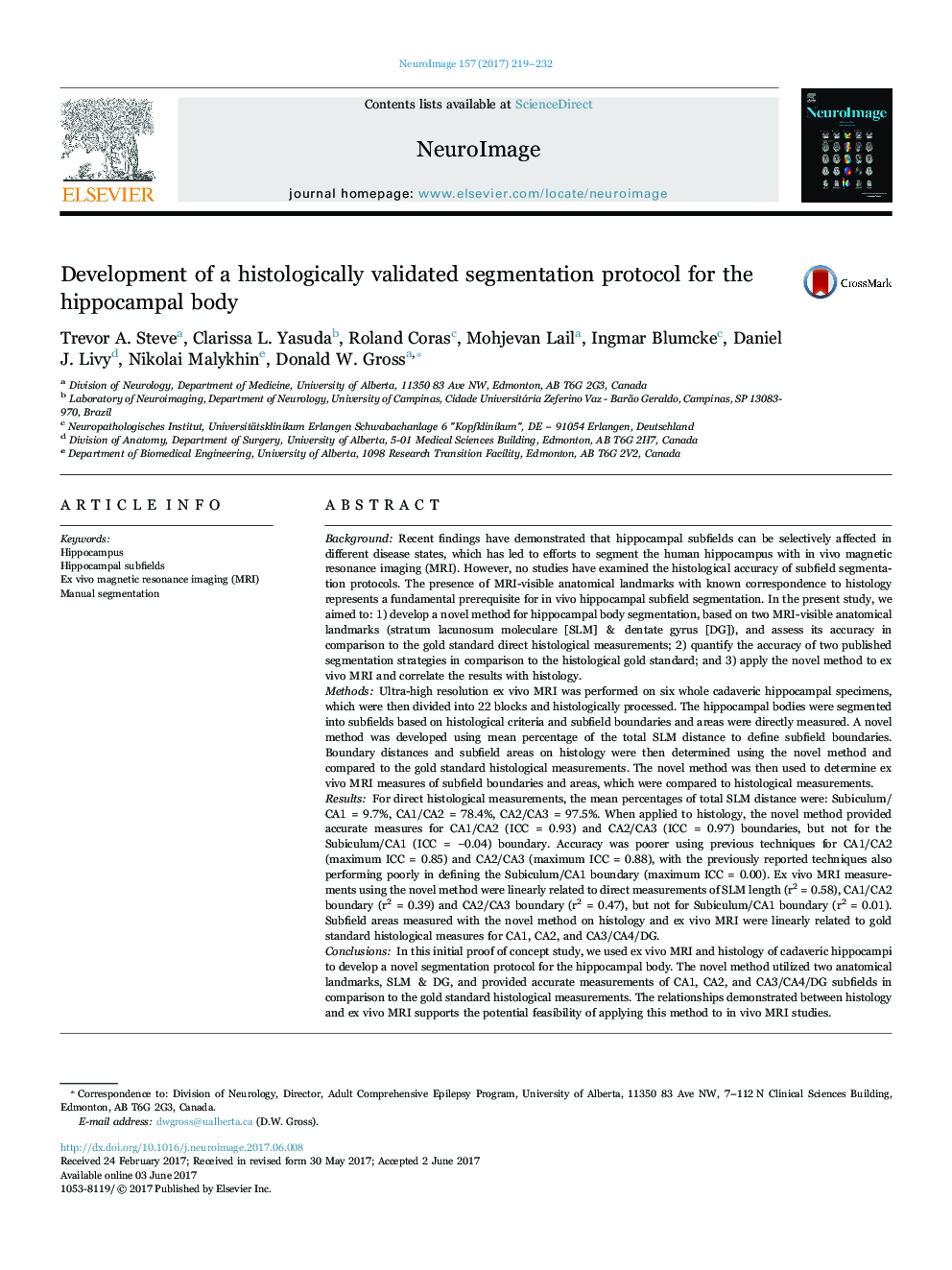| کد مقاله | کد نشریه | سال انتشار | مقاله انگلیسی | نسخه تمام متن |
|---|---|---|---|---|
| 5630912 | 1580853 | 2017 | 14 صفحه PDF | دانلود رایگان |
- Ex vivo MRI and histology of cadaveric hippocampi were examined.
- The authors developed a novel segmentation protocol for the hippocampal body.
- The method uses two MRI-visible anatomical landmarks, the SLM & DG.
- The novel method provided accurate measurements of CA1, CA2, and CA3/CA4/DG.
- Our results support the potential feasibility of application to in vivo MRI studies.
BackgroundRecent findings have demonstrated that hippocampal subfields can be selectively affected in different disease states, which has led to efforts to segment the human hippocampus with in vivo magnetic resonance imaging (MRI). However, no studies have examined the histological accuracy of subfield segmentation protocols. The presence of MRI-visible anatomical landmarks with known correspondence to histology represents a fundamental prerequisite for in vivo hippocampal subfield segmentation. In the present study, we aimed to: 1) develop a novel method for hippocampal body segmentation, based on two MRI-visible anatomical landmarks (stratum lacunosum moleculare [SLM] & dentate gyrus [DG]), and assess its accuracy in comparison to the gold standard direct histological measurements; 2) quantify the accuracy of two published segmentation strategies in comparison to the histological gold standard; and 3) apply the novel method to ex vivo MRI and correlate the results with histology.MethodsUltra-high resolution ex vivo MRI was performed on six whole cadaveric hippocampal specimens, which were then divided into 22 blocks and histologically processed. The hippocampal bodies were segmented into subfields based on histological criteria and subfield boundaries and areas were directly measured. A novel method was developed using mean percentage of the total SLM distance to define subfield boundaries. Boundary distances and subfield areas on histology were then determined using the novel method and compared to the gold standard histological measurements. The novel method was then used to determine ex vivo MRI measures of subfield boundaries and areas, which were compared to histological measurements.ResultsFor direct histological measurements, the mean percentages of total SLM distance were: Subiculum/CA1 = 9.7%, CA1/CA2 = 78.4%, CA2/CA3 = 97.5%. When applied to histology, the novel method provided accurate measures for CA1/CA2 (ICC = 0.93) and CA2/CA3 (ICC = 0.97) boundaries, but not for the Subiculum/CA1 (ICC = â0.04) boundary. Accuracy was poorer using previous techniques for CA1/CA2 (maximum ICC = 0.85) and CA2/CA3 (maximum ICC = 0.88), with the previously reported techniques also performing poorly in defining the Subiculum/CA1 boundary (maximum ICC = 0.00). Ex vivo MRI measurements using the novel method were linearly related to direct measurements of SLM length (r2 = 0.58), CA1/CA2 boundary (r2 = 0.39) and CA2/CA3 boundary (r2 = 0.47), but not for Subiculum/CA1 boundary (r2 = 0.01). Subfield areas measured with the novel method on histology and ex vivo MRI were linearly related to gold standard histological measures for CA1, CA2, and CA3/CA4/DG.ConclusionsIn this initial proof of concept study, we used ex vivo MRI and histology of cadaveric hippocampi to develop a novel segmentation protocol for the hippocampal body. The novel method utilized two anatomical landmarks, SLM & DG, and provided accurate measurements of CA1, CA2, and CA3/CA4/DG subfields in comparison to the gold standard histological measurements. The relationships demonstrated between histology and ex vivo MRI supports the potential feasibility of applying this method to in vivo MRI studies.
Journal: NeuroImage - Volume 157, 15 August 2017, Pages 219-232
